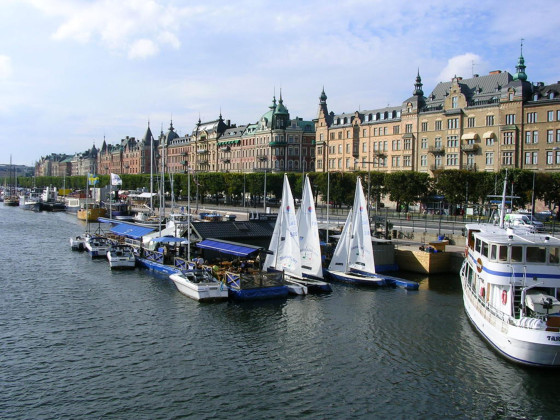Architecture is Not Something You Can Understand Just by Looking at the Apparent –II
In a minute you will be reading the second part of my Stockholm series in which I try to merge the information I gained from various sources with what I understood from the city and what my personal experience has been, collected under four topics: Sunlight, Water, Life Style and the State. “When the visible things in cites are abstracted from the invisible relations, we lose the deep perspective with regards to the meaning of the place,” I wrote in the first part, aiming to define a contextual frame. You can read the first part which includes the “Sunlight” section here.
Water
Water flows in the veins of the life based on light, which I have previously mentioned under the first heading. Stockholm is a not a city of canals like Amsterdam or Venice, yet when you look to the city from above, you can see how the land is scattered among the rivers and lakes that reach the ocean. The shipyard, where tremendous navy ships were once built, used to be the heart, and the key strength, of the kingdom’s capital. Despite the fact that the early 20th century’s technology-oriented industry of production for communication instruments, motor vehicles, weaponry and steel, had polluted these veins, due to certain decisions made at the end of the century, it is now possible to enjoy clean a seaside in every neighborhood surrounded by water.
The rhythm of leisure walks along the shore in Stockholm changes by the docks and ports. Looking from above and away from the shore, where water ways proceed so narrowly that they resemble canals, and viewing dozens of large and small boats create a feeling that the city “lives” its waters. To come across a line of boats during a park walk, all pulled up by the boatyard because of the winter weather, is vastly different from the feelings of exclusion caused by privately owned, no-access marinas in Turkey. In the urban life and its mood of leisure, a boat is almost exactly what a bicycle is. It is not a privilege, but a common area that brings people together.
Apart from the docks for medium-sized and larger ships, almost the whole shore consists of low docks and follows the natural coast line. The plants and reeds on the shore, coming right out of the water, smudge the waterline where the city parks meet the water. The breathtaking layout of the islands is also phenomenal. The islands, around which speedboats and ferries float during summer days, fall into ways of silence during the winter months, yet they still possess a deserted beauty.
The fresh water of the lakes and the salty water of the ocean blend in the city. The plantation also differs on the shores depending on the type of the water. The scents created by different iodine rates of plants and water; and the sounds of plants, birds and water add a new layer to the urban experience. Apart from all these beautiful things, the pending climate changes and its possible effect on the sea levels, and the climate conditions that would reshape the city and its nature, supply an anxious, psychological dimension to the city.
Life Style
The Stockholm life style is based on its residents’ humble and quiet way of life, playing games with the sun and spending days as if by the lips of water. Responsibilities and personal lives are shared in the common kitchens at work places, be them private or governmental, or in the laundry rooms of buildings. The stroller and bicycle ramps attached to all stairs make existing in the city a joy rather than a struggle. Social rights gained through midcentury struggles, and the political environment that comes from it, give way to a life that is preserved by its state structure.
2014 numbers show that the average wage in Sweden is approximately three and half times its counterpart in Turkey. The gap between the highest and lowest income groups is quite striking; yet it is the medium income group’s high standards of life that determine the ways of life in the city.
Low population, vast lands, production of valuable products and services, strong character of the social state, and a tradition of fair distribution, create an ecosystem where the state supports everyone from the moment they come to life. This very system that encourages individuals to create their own existence when they turn 18 by becoming independent and leaving the economic unit of the family, also enables young parents to become independent again at middle age. Thus so many things traditionally labeled as the styles and pleasures of the young, are freed from societal roles defined by age. Now following that introduction, try imagining the notion of liberated woman and man, and the consequent varieties of love, art and urban life. It is clear that this system which provides enough time to refine individual tastes also creates individuals focused on enjoying life. This refined taste is reflected on everything from fashion to decoration, food culture to vacation preferences. The rumor that Sweden has a very high rate of suicide is only an urban myth disproved by the long-term statistics. This life style, however, cannot prevent the separation of people who live in the city center and in the suburbs. It is worth noting that the dynamics in the suburbs where mostly immigrants and low income groups reside are quite different from the city center.
The third and last part: State
Related Content:
-
Architecture is Not Something You Can Understand Just by Looking at the Apparent - III
The creation processes of the city, like most of everything else in it, are under the strict control of the government.
-
Architecture is Not Something You Can Understand Just by Looking at the Apparent - I
When the visible things in cites are abstracted from the invisible relations, we lose the deep perspective with regards to the meaning of the place
-
Izmir: A Big Wedding Hall
“Izmir is a big wedding hall,” Tamer Varış once said. Considering the feeling the local governing bodies generate as they are managing the urban culture, he is not wrong.
 29.01.2016
29.01.2016





